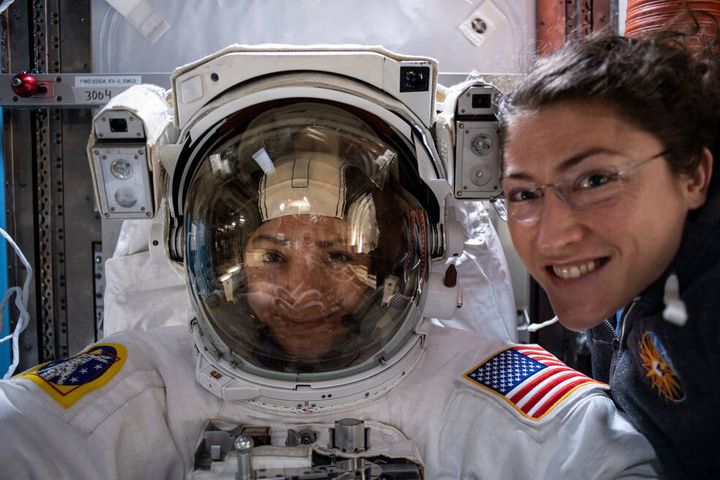Two astronauts have made history as the first ever all-female team to conduct a space walk.
Christina Koch and Jessica Meir, both Nasa astronauts, are carrying out a spacewalk outside the International Space Station (ISS) in order to replace a faulty battery weighing 105.2kg.
In the process they will become the first female-only team to spacewalk, 54 years since Russian cosmonaut Alexei Leonov first stepped into space.
Nasa are live-streaming the historic event – which has taken on an even greater significance in the wake of a widely-reported spacesuit sizing issue earlier this year.
Koch and fellow astronaut Anne McClain were primed to undertake the first ever all-female EVA (extravehicular activity) in March, but it was called off when it became apparent there wasn’t enough time to get a second medium-sized spacesuit ready to fit the two women.

All of Nasa’s astronauts aboard the station are equipped to carry out the task of replacing the enormous battery, CBS reported, however Koch and Meir were selected to set foot outside the station together.
While Koch has undertaken three previous spacewalks, it will be Meir’s first ever excursion outside the station, and the 221st in the history of the International Space Station.
Electrical engineer Koch has been living aboard the station since March, iNews reported, whilst Meir, a marine biologist, joined the crew in September. Both are members of Nasa’s Astronaut Class of 2013.
Koch is set to break another record during her time aboard the station – with an expected stay of 328 days she will set the precedent for the longest single spaceflight by a woman.
Viewers watching the livestream will be able to differentiate Koch and Meir by the differences in their space suits – Koch’s h red stripes, whilst Meir’s is unmarked.
Cameras mounted on the astronauts’ helmets show their work in detail as they move around the exterior the station, harnessing themselves to the base whilst they complete the complex task.
The mission is expected to last five-and-a half hours, and if time allows, the astronauts will not only replace the battery but will also adjust insulation around parts of the station, route an ethernet cable, and install a new fitting onto the European Space Agency’s Columbus laboratory module.
The astronauts themselves may be treating Friday’s mission as little more a maintenance trip, but the world will be watching as they step out into space.
The pair have been wished well by a number of leading scientists and astronauts past and present, including the UK’s Tim Peake who spent six months at the station after launching in December 2015.
Looking Back At The Women Who Made Space History
By Amaliah S. Marmon-Halm
In honour of Friday’s historic event, we are highlighting some of the women who made space history.
The Woman Who Calculated The Apollo Moon Landing – Katherine G. Johnson
Katherine G. Johnson was hired as a research mathematician with the National Advisory Committee for Aeronautics (NACA), the agency that preceded Nasa, at the Langley Research Center in 1953, after they opened hiring to African-Americans and women.
Her computations were critical to the success of the Apollo Moon landing programme and the start of Nasa’s Space Shuttle programme, both of which have influenced every major Nasa space programme since.
The First Woman To Fly To Space - Valentina Tereshkova
The first woman to travel in space was 26-year-old Soviet cosmonaut, Valentina Tereshkova.
In June 1963, Tereshkova was launched on a solo mission aboard the shuttle Vostok 6, where she spent more than 70 hours orbiting the Earth.During her mission, Tereshkova conducted experiments to learn about the effects of space on the human body and helped identify aerosols in the earth’s atmosphere.
The Developer of the Hubble Telescope - Nancy Grace Roma
Nancy Grace Roman, also known as the “mother of the Hubble Space Telescope”, helped develop the space-based observatory which provided some of the clearest images we have seen to date of the galaxy.
During her time at Nasa, she paved the way for women to take on leadership positions at a time when women were not encouraged to pursue a career in science, technology, engineering and maths (Stem).
She was the first chief of astronomy in the Office of Space Science at Nasa headquarters and the first woman to hold an executive position at Nasa.
The First British Woman In Space - Helen Patricia Sharman
Helen Sharman, a confectionary chemist by profession, became the first British person to fly in space when she visited the Mir space station aboard the Soyuz TM-12 in 1991.
She got her chance by responding to a radio advert looking for people to participate in the space station mission in 1989.
During this flight, she also became the first woman to visit the Mir space station.
The First African-Amercian Woman In Space - Mae C. Jemison
In September 1992, Mae C. Jemison became the first African-American woman to travel into space.
She travelled along with six other astronauts were on board the Endeavour for an eight-day mission.
She said has the flights of Sally Ride (who was the first American women in space) and Guion Bluford in 1983 inspired her to apply to the astronaut programme.
The First Female Shuttle Commander - Eileen Collins
Having worked as a space shuttle pilot since 1995, former military instructor and test pilot Eileen Collins became the first female space shuttle commander on the STS-93 mission of the shuttle Columbia in 1997.
Her mission was to orbit the Earth and deploy the Chandra X-Ray Observatory. She retired from NASA in 2006.
